Are you ready to take your taste buds on a trip to Southeast Asia? Look no further than this vegan mie goreng recipe! This popular Indonesian fried noodle dish, also sometimes referred to as Mee Goreng, features veggies, tempeh, and fried tofu slices, all coated in a delicious blend of sweet and savory sauces.
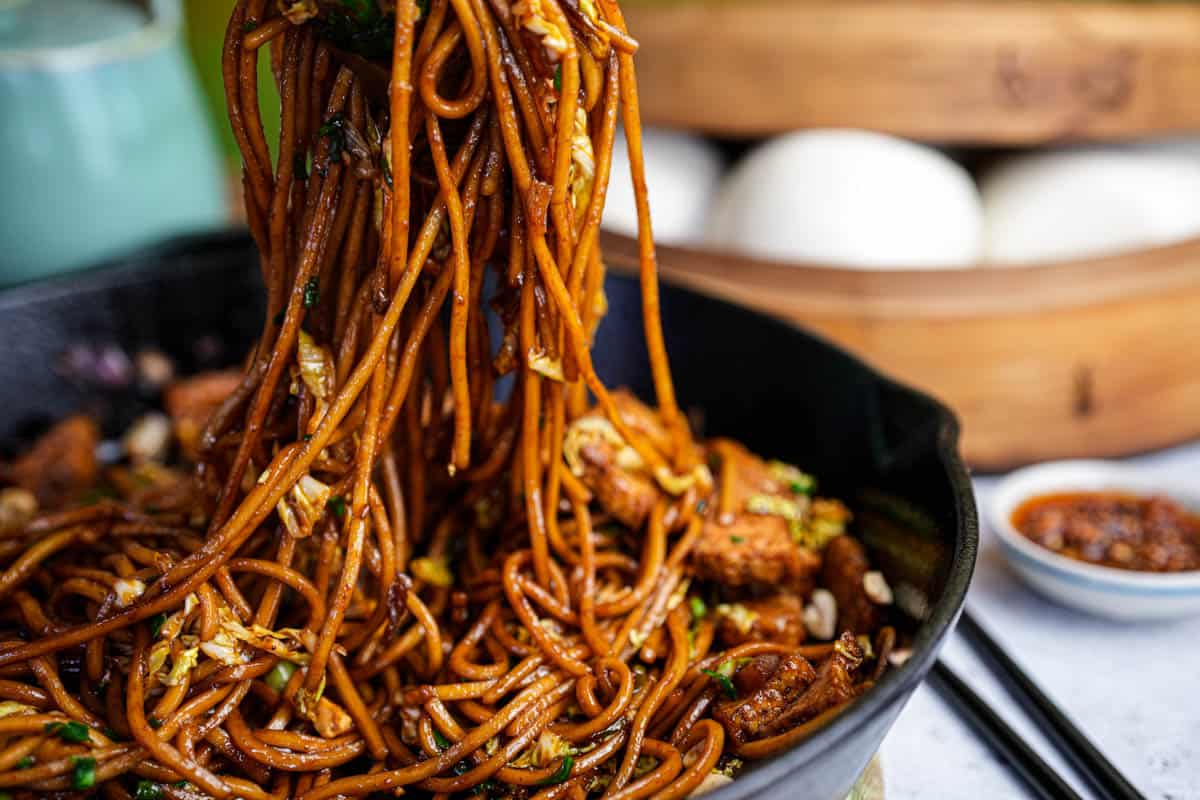
If you are looking for a thicker-noodled Indonesian noodle dish, you might want to check out my killer recipe for bami goreng. I included some gluten free variations in the body of this blog post, or you can just make these killer stir-fried glass noddles instead, which are also the BOMB.
With its unique blend of flavors and textures, vegan mie goreng is a perfect introduction to the exciting world of Indonesian and Malaysian cuisine. And the best part? This mind-blowing and quick-to-make weeknight meal is completely plant-based, without sacrificing any of the bold and satisfying flavors.
So grab your wok and let's get cooking!
Jump to:
- 🥰Why you are going to adore the ever-loving heck outta this recipe
- 🥬Notable ingredients
- 🍜Noolos
- 📖Step-by-step instructions
- Step 5
- 🔄Substitutions
- 🌴Can’t find Kecap Manis, or want to make your own?
- 👉Variations
- 💪Want to get more protein into this dish?
- 🍽️Serving ideas
- ❗️Top tips
- 🤷♀️Recipe FAQs
- ✌️Other dishes that go great with this:
- Mie Goreng (Indonesian Stir-Fried Mee Goreng Noodles)
🥰Why you are going to adore the ever-loving heck outta this recipe
- This recipe is a very fast one-pan meal. It will not leave you with much kitchen cleanup and will be ready in minutes, not hours.
- This is a protein-packed meal, and it's easy to sneak extra veggies into it. So it can be a balanced healthy meal that even picky eaters will love the heck out of.
- It’s completely plant-based and easy to make gluten-free just by using rice noodles.
🥬Notable ingredients
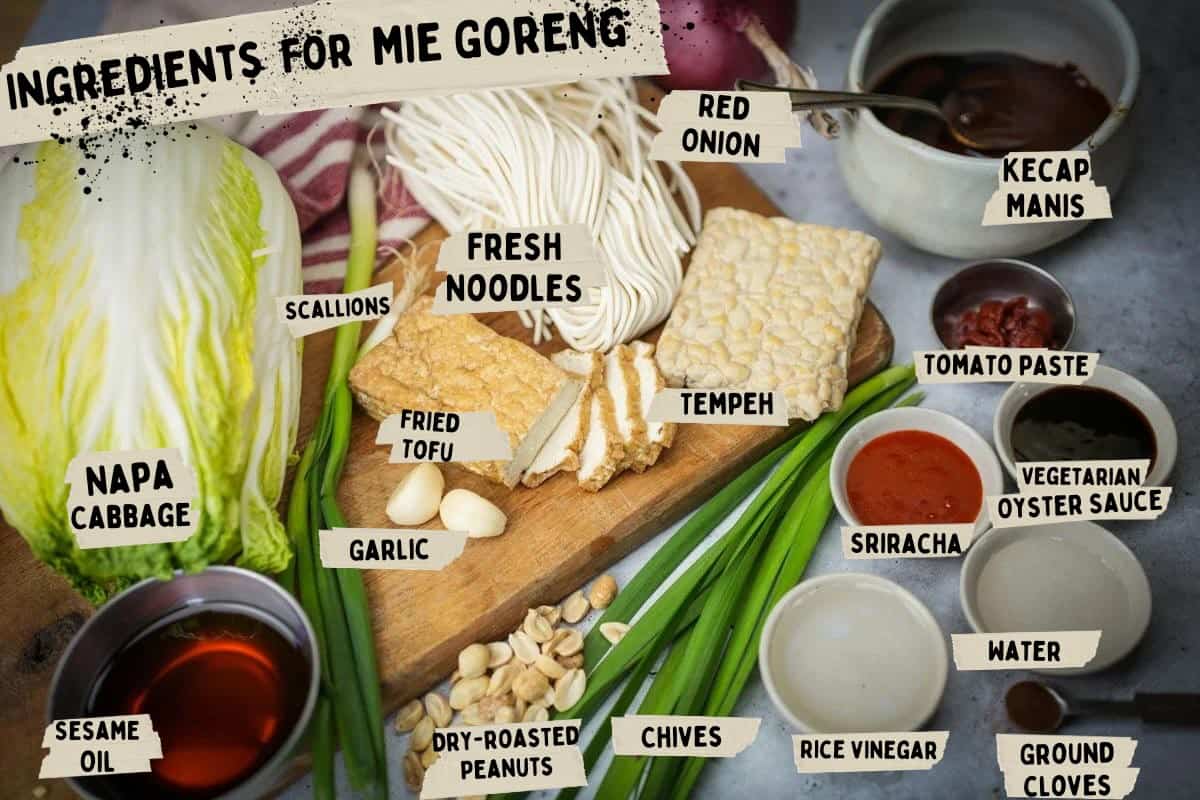
- Noodles! There are indeed many noodles that will make a killer mie goreng. I actually wrote a whole section just below this general ingredients section, to help you figure out what the best (and worst) options are. So read all about ‘em down below! ⬇️
- Pre-fried tofu: The almost pork-like texture of the tofu pairs perfectly with the chewy noodles and the bold flavors of the sauce. And as a bonus, pre-fried tofu is readily available at most Asian grocery stores and can be a convenient time-saver when preparing this flavorful Indonesian dish. Don’t worry, if pre-fried tofu isn’t available where you are, here’s all you need to do: cut a 14 oz. block of firm tofu in half. Deep fry (or air fry) the half a block of tofu until lightly golden brown on the outside. Allow it to cool, and then slice the tofu into ¼ inch thick slices.
- Kecap manis: Kecap manis also known as sweet soy sauce, is a thick, sweet and savory condiment that is commonly used in Indonesian and other Southeast Asian cuisines. It is made from a combination of soy sauce, palm sugar, and various spices such as garlic, star anise, and galangal. Kecap manis has a complex, umami-rich flavor and is often used as a marinade, dipping sauce, or cooking ingredient in dishes like nasi goreng (fried rice), satay, and mie goreng (fried noodles). If you can’t find it, I wrote a recipe about halfway down this page so you can make your own at home.
- Tempeh: Tempeh is a traditional Indonesian food made from fermented soybeans, and sometimes rice and other grains that have been formed into a firm, cake-like shape. It has a nutty, earthy flavor and a firm, chewy texture that makes it a popular meat substitute in dishes like sambal goreng. Tempeh is a great source of protein, fiber, and various nutrients, making it a healthy and nutritious addition to any diet.
- Vegetarian oyster sauce: Vegetarian/vegan oyster sauce is a flavorful and versatile condiment that is typically made from mushrooms, soy sauce, sugar, and various seasonings. Rather than being overly fishy tasting as you might expect a riff on oyster sauce to be, it is umami-rich, slightly sweet, and pungent, which lends itself perfectly to mie goreng.
- Cabbage: I prefer napa cabbage or Chinese cabbage for this recipe. But you can totally get away with regular ol’ green cabbage. It just will not be quite as tender, so consider cutting it into smaller pieces before you cook it.
See the recipe card at the bottom of this page for the complete list of ingredients and their quantities.
🍜Noolos
I worked in a restaurant once where I kept seeing a bucket in the walk-in fridge labeled “Noolos”. It turned out one of the South American dishwashers was storing noodles in there and wrote it that way.
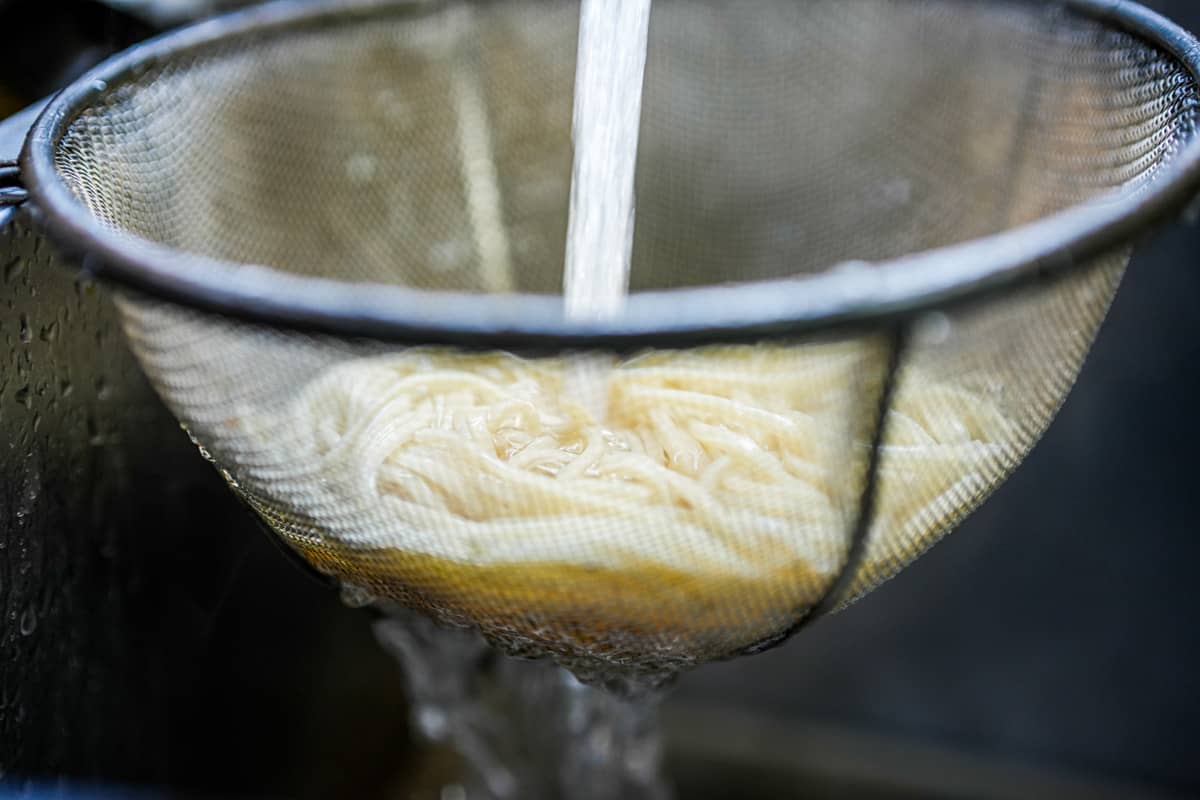
Anyway, the type of noodle you use for Mie Goring can significantly affect the taste and texture of the final dish. Here are some of the best types of vegan noodles for making this dish:
- Ramen Noodles: Instant ramen noodles are a versatile choice for Mie Goreng, as they are thin and springy, with a slightly chewy texture. They are typically made with wheat flour, salt, and water, and cook super fast (they don't call them instant noodles for nothing, ya know?). Many street vendors in Indonesia actually use noodles like this, because as a stir fried noodle, the wavy shape does a great job at carrying the sauce bits of veggies better than a flat noodle might.
- Hokkien Noodles: Hokkien noodles are a type of Chinese wheat noodle that is thicker and chewier than other types of noodles. They have a slightly sweet flavor and are often used in stir-fried dishes like Mie Goreng.
- Udon Noodles: Udon noodles are thick, white Japanese noodles made from wheat flour. They have a chewy texture and a neutral flavor that pairs well with bold, spicy sauces.
- Rice Noodles: Rice noodles, which also happen to be gluten-free, are a popular choice for Mie Goreng in Thailand and other Southeast Asian countries. They are thin, translucent noodles made from rice flour, giving them a delicate texture and a slightly sweet flavor.
- Fresh Shanghai style noodles: These noodles are a little on the thicker sides, and make a perfect egg-free choice for mee rebus, or Vietnamese stir-fried noodles. Fresh Shanghai noodles can usually be found in the refrigerated section of Asian grocery stores or specialty markets. They should be stored in the refrigerator and used within a few days of purchase for the best flavor and texture.
- If you want to see a crazy dope recipe which uses stretchy glass noodles, go make this flavorful-as-heck pad woon sen!
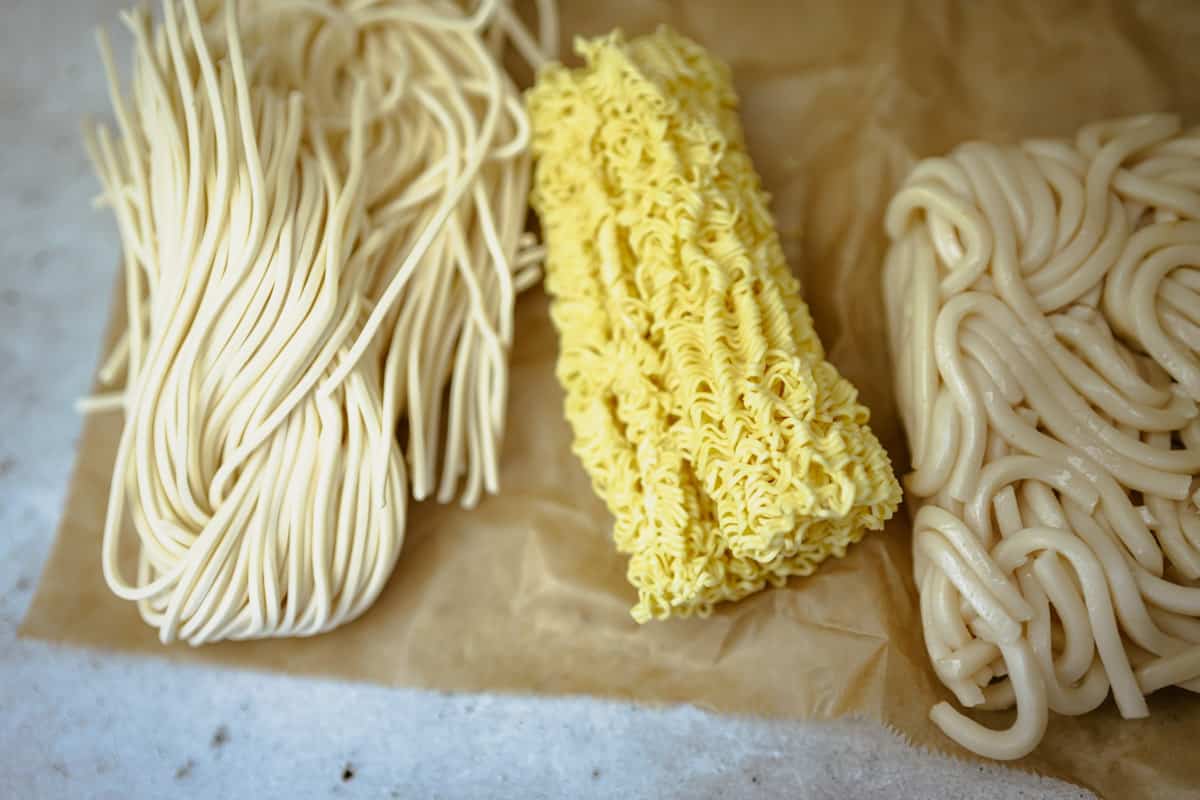
🙅♀️What noodles NOT to mess with for this dish:
Lo mein noodles: Lo mein noodles are a type of Chinese egg noodle made from wheat flour, eggs, and water. They have a slightly chewy texture and a yellow color, and if they were vegan they would be PERFECT for making mie goreng. But since you give a damn about not harming animals, you should avoid them.
Yellow wheat noodles: Like lo mein noodles, most dried yellow wheat noodles either contain egg or artificial colors in them. Unless you want to eat either of those things, I would encourage you to skip these bad boys.
Spaghetti: is not typically used in Asian noodle dishes because it has a different texture and flavor compared to Asian noodles. Spaghetti is typically made with durum semolina. Durum semolina is a type of flour that is made from durum wheat, a hard variety of wheat that is commonly grown in the Mediterranean region. It is a coarse, granular flour that is high in protein and gluten, which gives it a strong, elastic texture when mixed with water. Asian noodles are specifically designed for different types of dishes and have a chewy texture that complements the other flavors and textures in the dish. They actually work great in these stir fried Burmese curry noodles.
End of rant. Don’t use spaghetti. Sorry.
📖Step-by-step instructions
You wanna see how this yummy thing gets made? I am going to grab you by the hand and walk you through the majestic rolling mountains of noodles in this handy step-by-step photo guide. Or you can follow along with the easy-to-print recipe card towards the bottom of this page. Either way, I want you to know that I love you and I know you can definitely accomplish making this recipe!
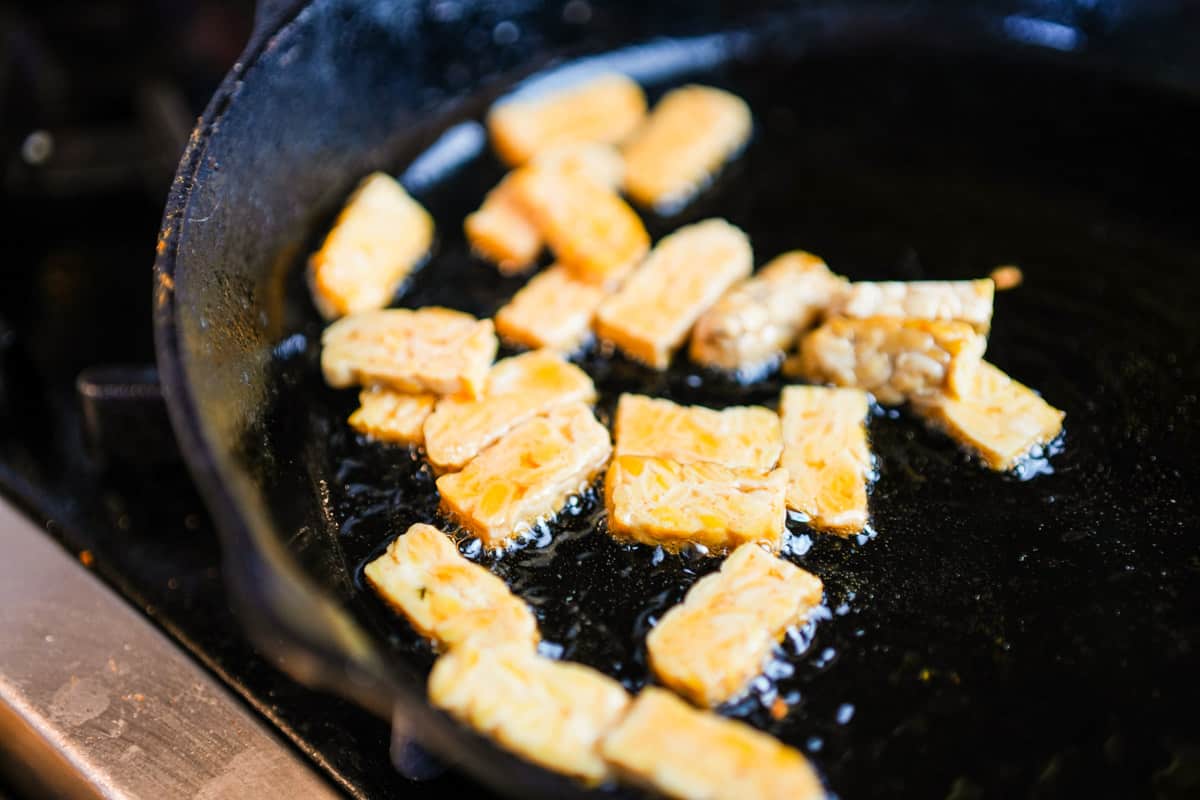
Step 1
In a hot wok or skillet, heat sesame oil for 60 seconds. Then, add tempeh and sauté on high heat for 3 minutes until it turns golden all around.
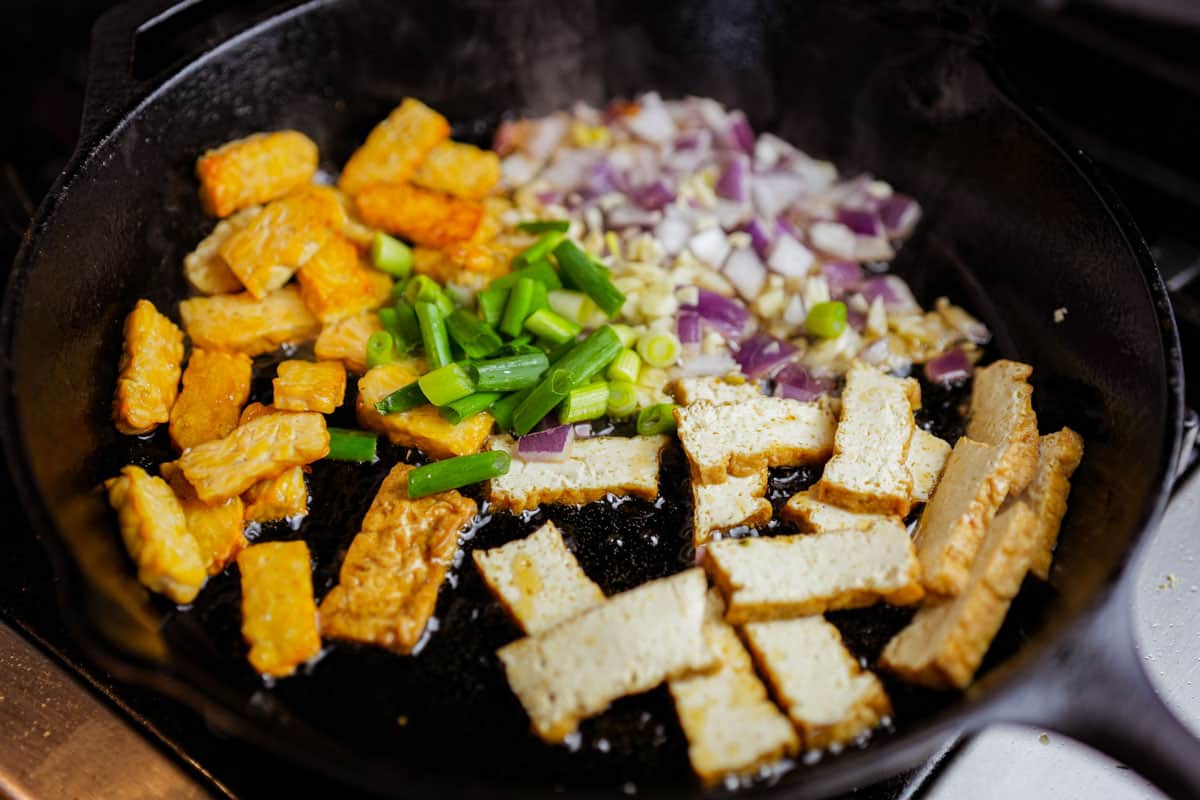
Step 2
Decrease to medium heat, and add pre-fried tofu strips, onion, scallions, and minced garlic. Stir fry for 3 minutes until tender and fragrant.

Step 3
While sautéing, mix all sauce ingredients in a small bowl using a fork to get a smooth texture.
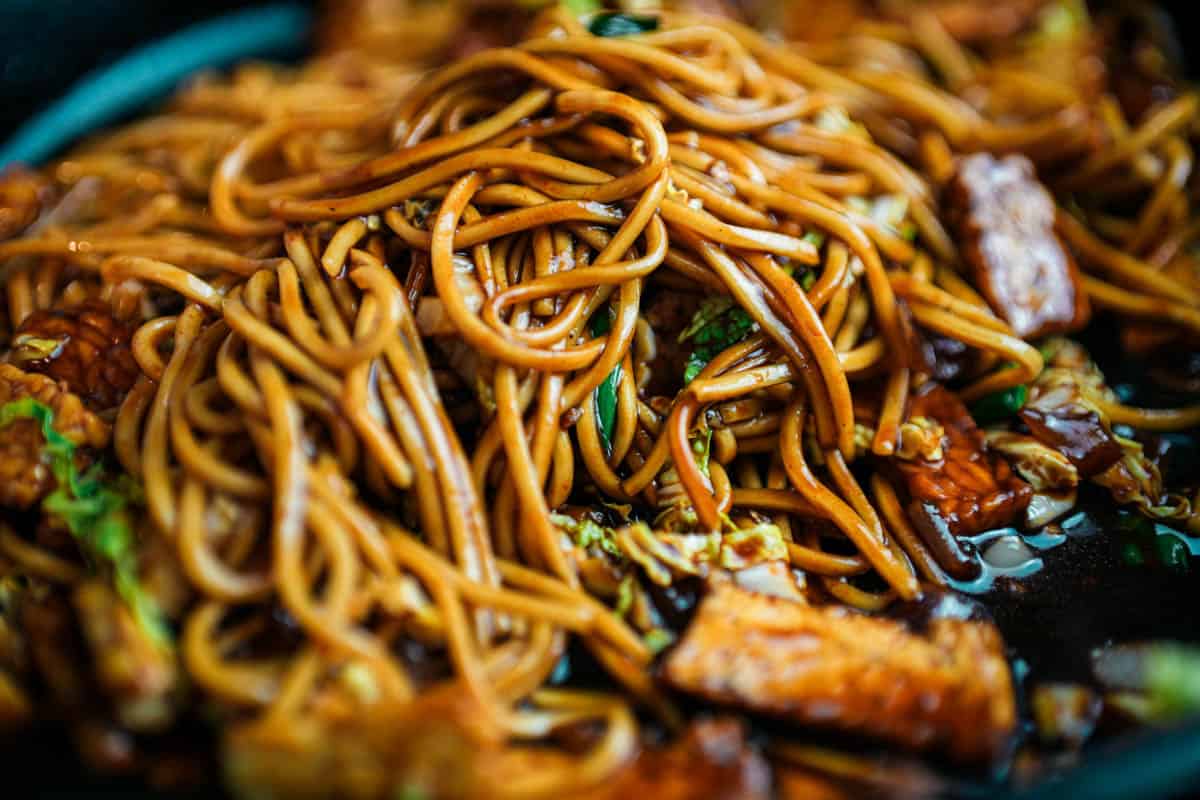
Step 4
Add cabbage, pre-cooked noodles, and sauce to the pan. Stir-fry for 2 minutes until all ingredients are well combined and the noodles are heated.
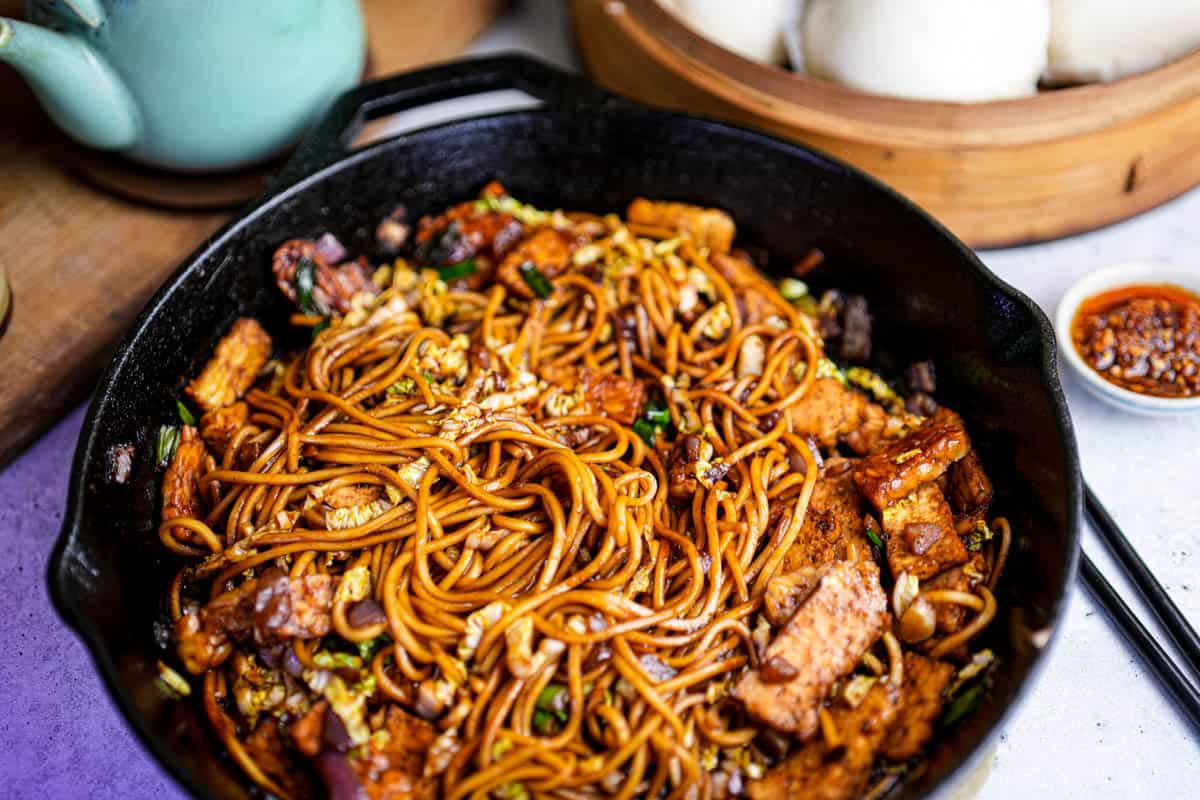
Step 5
Transfer to a serving bowl and garnish with chopped peanuts, scallions, and sambal olek or chili crisp according to your taste.
🔄Substitutions
- Kecap Manis- Don't worry if you don't have kecap manis, my quick, easy-to-make homemade version can be a great substitute! I am giving ya a complete mini-recipe for making it Just below this substitutions section.
- Spiralized veggies instead of Noodles- If you're looking for a healthier option, try substituting spiralized vegetables for noodles in your mee goreng. You'll get all the flavor and satisfaction of the dish, with the added benefit of more nutrients and fewer carbs. My favorite vegetables to make spiraled noodles out of are celery root, zucchini and summer squash. No need to pre-cook them. Just add them towards the end of the stir frying at the same stage you would normally add cooked noodles, and stir fry until they are heated throughout.
- No vegetarian oyster sauce? No prob. Mushroom sauce or hoisin sauce can be a good vegan substitute for vegetarian oyster sauce as they provide a similar savory, sweet and umami flavor.
🌴Can’t find Kecap Manis, or want to make your own?
Kecap Manis might be tricky to track down if you don’t have a good local Asian food market. Making it yourself is easy! This little recipe just makes a half cup, so multiply it out if you want a full bottle to keep on hand.
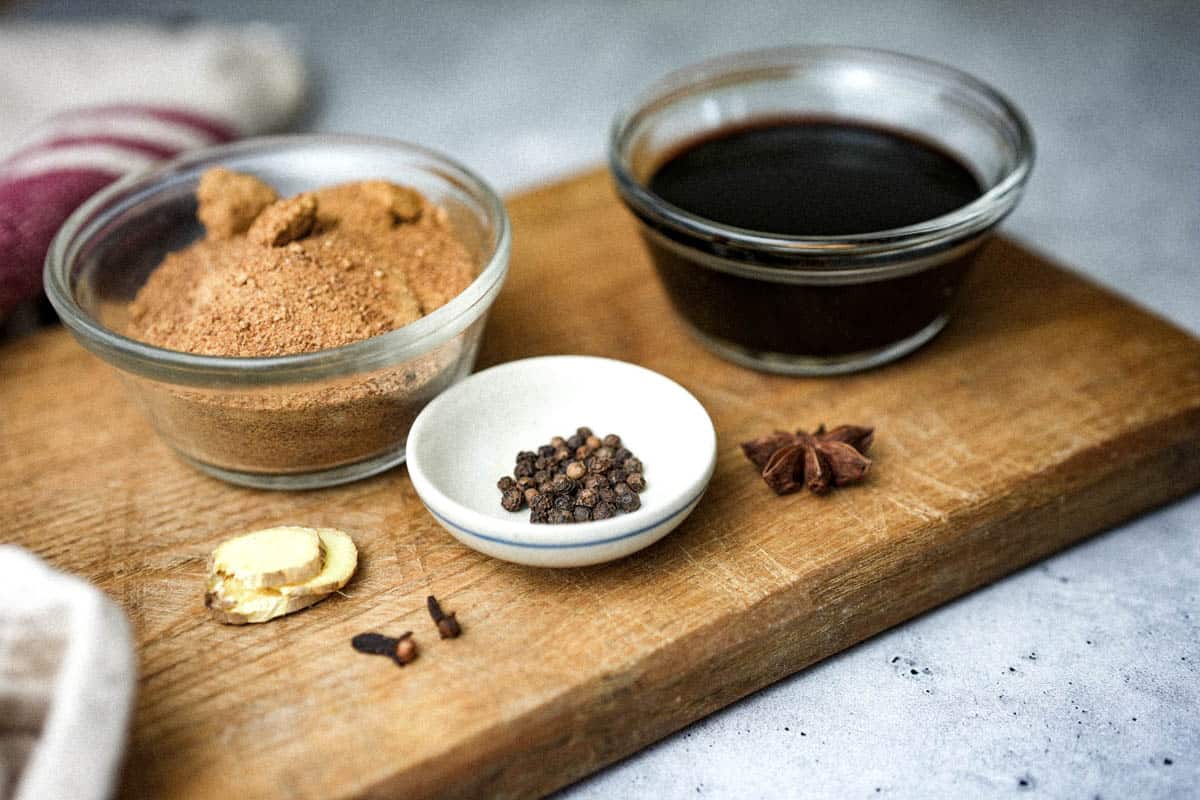
Ingredients for Kecap Manis
- ½ cup soy sauce, tamari or shoyu
- ½ cup coconut sugar, palm sugar, or brown sugar
- 1 teaspoon molasses
- 1 whole dried star anise
- 2 thin slices of fresh ginger
- ½ teaspoon black peppercorns
- 2 dried cloves
Place all ingredients into a saucepan, and bring up to a boil over a high flame. As soon as the contents of the pot are bubbling, reduce the heat to a simmer, and cook the sauce, stirring occasionally for 10 minutes to thicken it. While the sauce is still hot, pour it through a strainer into a jar to remove the whole spices. Cool the sauce and store in the refrigerator. The Kecap Manis will stay good in the fridge for months.
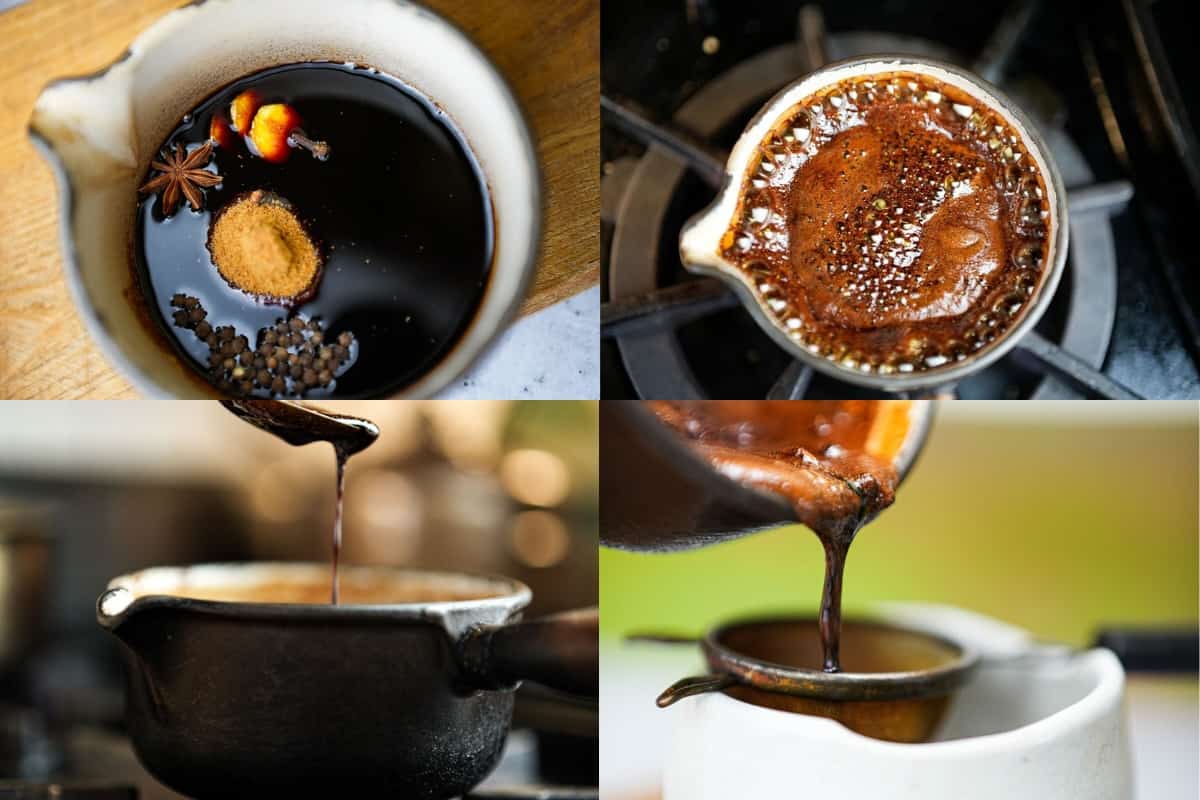
👉Variations
- Korean-style Mie Goreng - Add 1 spoonful of gochujang bbq sauce, and ⅓ cup of chopped kimchi. You should def try my recipe for homemade kimchi, because it is so good in stir-fried noodles, or in fried rice dishes.
- Thai-style Mie Goreng - Add kaffir lime leaves, a spoonful of tom yup paste, and fresh Thai basil, and garnish the dish with bean sprouts for a Thai-inspired version of Mie Goreng.
💪Want to get more protein into this dish?
Here are a few additions you can pick from to bump up the protein, in case you want to hulk out of your t-shirt like a damned wrestler or whatever.
Seitan - Seitan has a chewy meaty texture and has more protein in it than meat. You can check out my vegan chicken recipe if you would like to make it from scratch.
Edamame - boiled or pan-fried edamame can be added to add a pop fresh and crunchy texture to the dish.
Soy curls- these dried strips of soy protein are super meaty. You can rehydrate them in a flavorful broth and add them right into the pan as you stir fry the other ingredients before adding your mie goreng noodles.
Bean spouts - While bean sprouts are not a high source of protein compared to other plant-based protein sources, they can still be a nutritious addition to this dish, providing fiber, vitamins, and minerals. You can add about a cup of them in at the same time you are sautéing the cabbage.
Mushrooms - sliced mushrooms such as shiitake or oyster mushrooms can add a meaty texture and umami flavor to the dish.
🍽️Serving ideas
Mee goreng is a nice complete meal on its own, but a few things I like to serve with it are:
- Crispy rice dumplings
- Nasi Dengaku (Miso glazed eggplant) or sambal goreng tempeh.
- Pickly stuff such as pickled burdock, pickled green chilies, Spicy marinated cucumbers, pickled carrot, green mango achar, red or green fermented chili paste.
- Indonesian coconut milk and vegetable soup made topped with banana leaf compressed rice cakes (lontong).
- Ketoprak- a Jakarta salad with fried tofu and spicy peanut dressing.
- There is not a single thing wrong with adding a little minced kimchi to this recipe, and boyyyyyyoboy have I got a killer kimchi recipe for you if you need one!
- Want more protein in your meal?! Make this with my tofu sisig, tofu katsu, or vegan fried chicken, you wild-ass muscle-man, you.
- Don't miss dessert! Make these THICK and fluffy Indonesian pancakes with chocolate and peanuts, Che ba mau, kuih dadar, or Vietnamese banh flan.
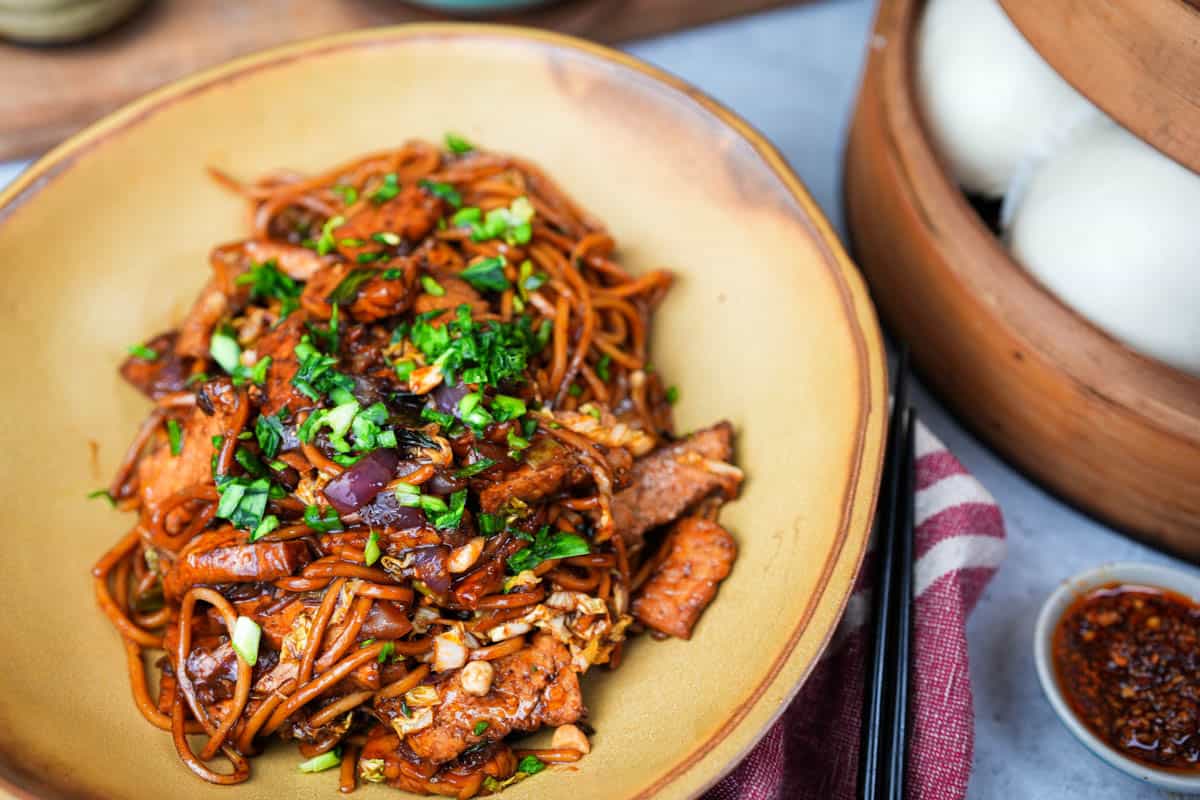
❗️Top tips
Don’t over cook your noods!
When you are initially preparing the noodles, try to keep them a little on the al dente side. Remember they will cook a bit more when being stir fried.
If you use rice noodles:
You will want to just soak rice noodles in water rather than boil them before you use them in this dish. Rice noodles only need to be soaked until they are pliable but still firm to the touch. Do not soak them for too long, as they will continue to soften when you cook them. For medium-sized rice noodles, soak them in hot water for about 8-10 minutes, or until they are just pliable but still firm. After soaking rice noodles, rinse them in a colander under cold running water to remove extra starch.
If you leave your noodles a'waiting:
If you aren’t going to be using your cooked or soaked noodles immediately to make men goreng, massage a small amount of sesame oil into them to prevent them from sticking together.
If you add more proteins, here's how you deal with that:
If you are adding extra proteins, add them at the initial stage of stir-frying, the same time when the tempeh is cooking. That way the seitan, mushrooms, soy curls or whatever else you are adding has time to become lightly browned and cooked through before you add the noodles and other ingredients.
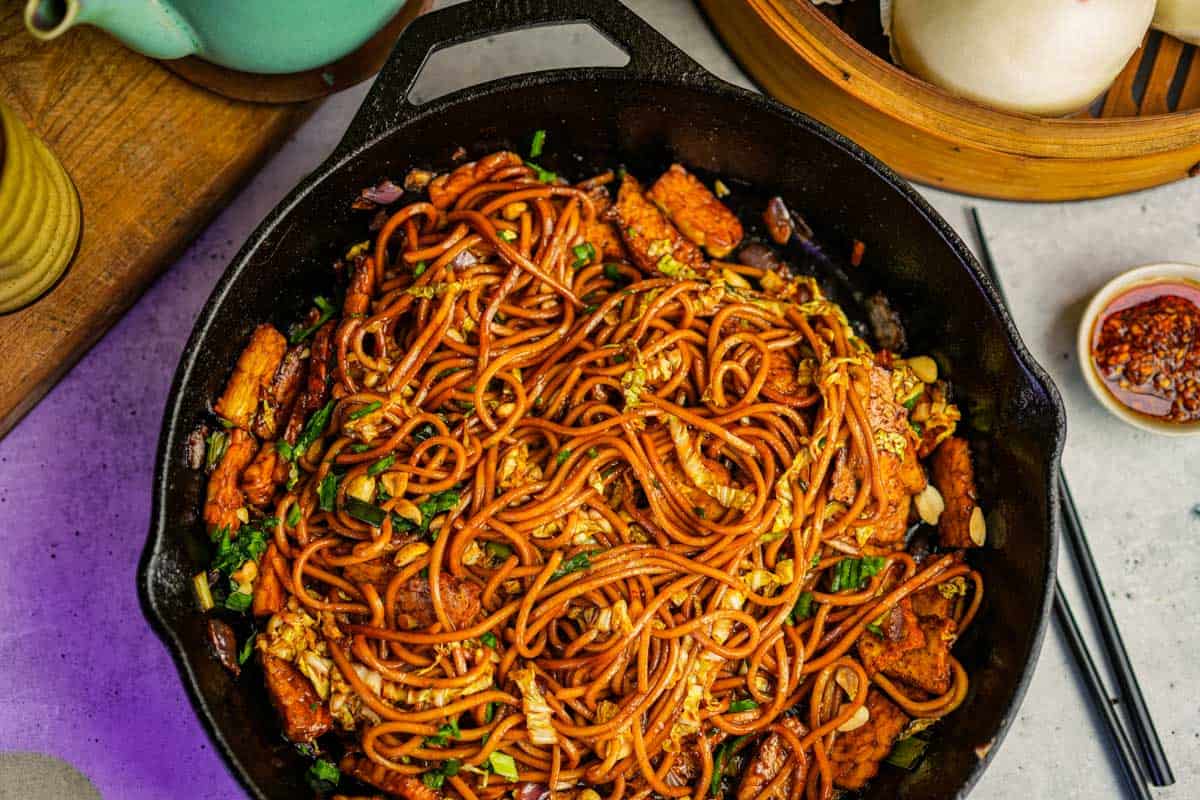
🤷♀️Recipe FAQs
The Indonesian version of mie goreng uses fresh yellow noodles and sweet soy sauce, while the Malaysian version often uses thin egg noodles and a mix of sauces including soy sauce, oyster sauce, and/or tomato sauce. The Malaysian version may also sometimes include ingredients like shrimp paste or curry powder, which are less commonly used in the Indonesian version.
The word "ketchup" actually comes from the Hokkien Chinese word "kê-tsiap," which refers to a sauce made from fermented fish. This sauce was introduced to British traders in Southeast Asia.
Back in England, the British adapted the recipe by using locally available ingredients such as mushrooms, walnuts, and oysters, and created a thick, dark sauce. This sauce was initially called "ketchup" or "catsup" and became a popular accompaniment to meat dishes in the 18th century.
In the early 19th century, Americans began to experiment with tomato-based ketchup. The first commercial tomato ketchup was produced by H.J. Heinz in 1876, and it quickly became the most popular condiment in the United States.
Meanwhile, Kecap evolved in Indonesia and Malaysia to become less often a preserved fish sauce, and more often a soy sauce, sweetened with coconut sugar and molasses and spices like clove and star anise.
The main difference between the two dishes is that mie goreng is made with noodles, while nasi goreng is an Indonesian fried rice dish. They are both typically served as a main course and can be customized to include a variety of different ingredients, depending on region and personal preference.
🥶Storage: If you have leftover Mie Goreng, store it in an airtight container and refrigerate it within 30 minutes of cooking. Mie Goreng can be stored in the refrigerator for up to 3 days.
🔥Reheating: When reheating, it is best to use a wok or frying pan to ensure that the noodles are evenly heated. Here are the steps to follow: Take the Mie Goreng out of the refrigerator and let it sit at room temperature for 10-15 minutes before reheating.
Heat a wok or frying pan over medium-high heat and add a small amount of oil.
Add the Mie Goreng to the pan and stir-fry for 2-3 minutes, or until the noodles are heated through.
If the noodles are dry, you can add a small amount of water or broth to the pan to help moisten them.
🍽️Serving: Once the Mie Goreng is heated through, transfer it to a serving dish and garnish with fresh sliced scallions, chopped peanuts, or fried shallots to add extra flavor and texture.
✌️Other dishes that go great with this:
Say Hi on Social! 👋
Follow me on Instagram & Facebook for more recipes.
❤️Love this recipe? It helps me out greatly if you leave a 5-star 🌟🌟🌟🌟🌟rating in the recipe card below and maybe even leave me a lovey-dovey comment too!
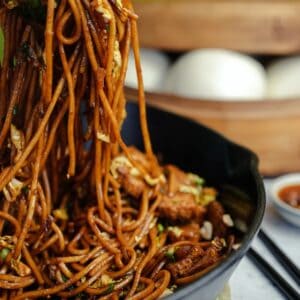
Mie Goreng (Indonesian Stir-Fried Mee Goreng Noodles)
Equipment
Ingredients
Stir-fry ingredients
- ¼ cup sesame oil
- 4 oz. Tempeh half package, sliced into ¼ inch strips
- 1 cup pre-fried extra firm tofu strips
- ¼ cup diced red onion
- 2 scallions roughly chopped
- 2 cloves garlic minced
- ½ cup shredded Napa cabbage
- 200 grams ramen noodles 200 grams rice noodles, or 230 grams fresh Shanghai style noodles, cooked
Stir-fry sauce ingredients:
- ¼ cup kecap manis
- 4 teaspoons tomato paste
- 1 tablespoon vegan oyster sauce
- 2 teaspoons sriracha
- 1 tablespoon rice vinegar
- ¼ teaspoon ground cloves
- 2 tablespoons water
To garnish:
- 3 tablespoons chopped roasted peanuts
- 1 thinly sliced scallion or 1 tablespoon minced chives
- Sambal olek or chili crisp to taste (optional for spice)
Instructions
- In a wok or large cast iron skillet over a high flame, heat the sesame oil for 60 seconds. When the oil is hot, add the tempeh to the pan. Sauté the tempeh on high heat for 3 minutes, turning the pieces regularly until lightly golden all around.
- Add the pre-fried strips of tofu, onion, scallions, and minced garlic, and lower to medium heat. Stir fry the ingredients together for 3 minutes until the onions, garlic, and scallions become tender and fragrant.
- While the tempeh, tofu and veggies sauté, mix together all of the ingredients for the sauce in a small bowl using the tines of a fork to break up clumps and get it smooth.
- Add to the pan the cabbage, pre-cooked noodles, and sauce, and stir-fry together for about 2 minutes until all ingredients are well combined and the noodles are heated throughout.
- Place in an attractive serving bowl and garnish with chopped peanuts, scallions, and sambal olek, or chili crisp to your taste.

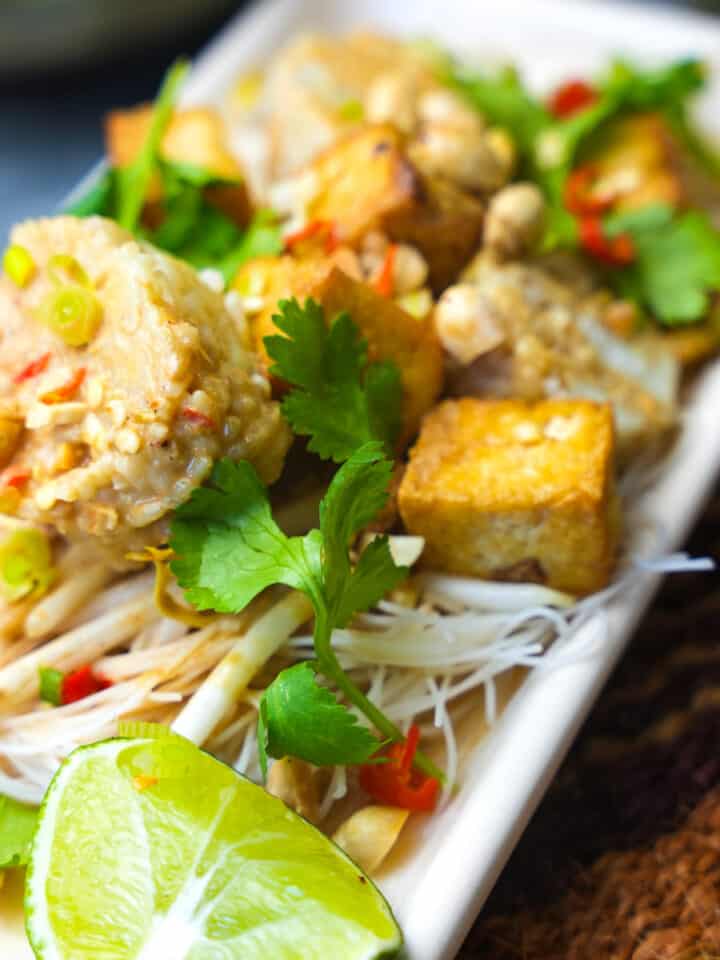
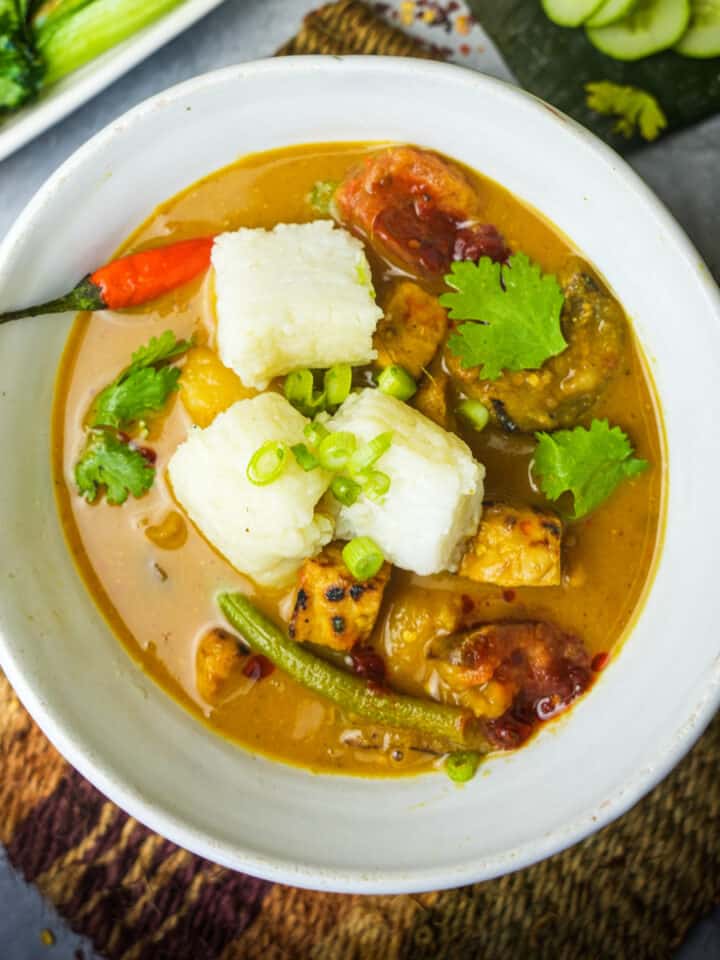
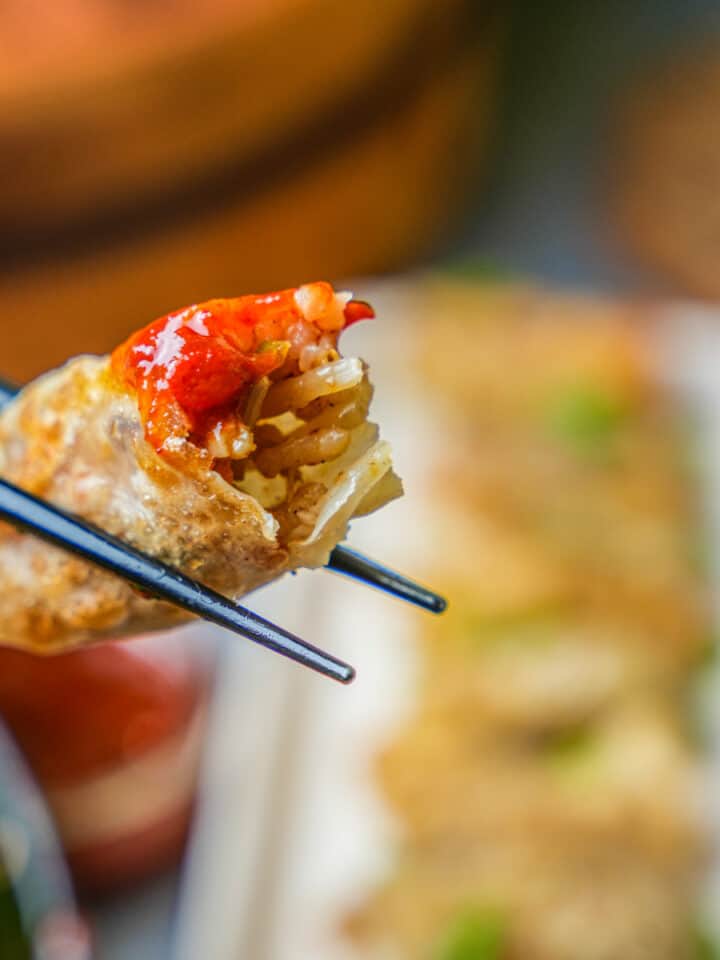
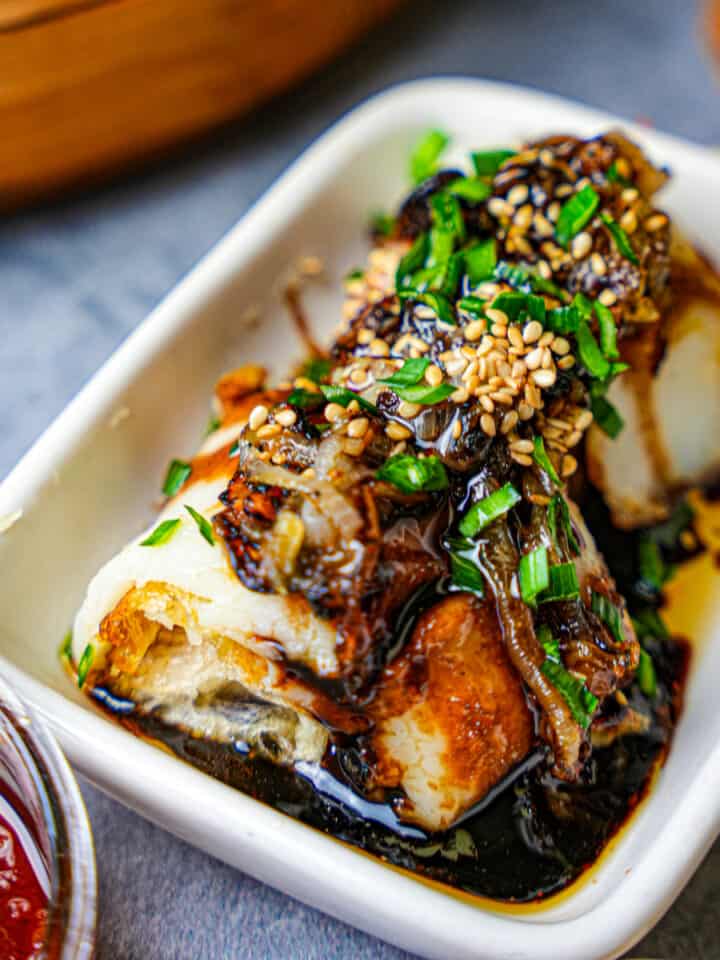
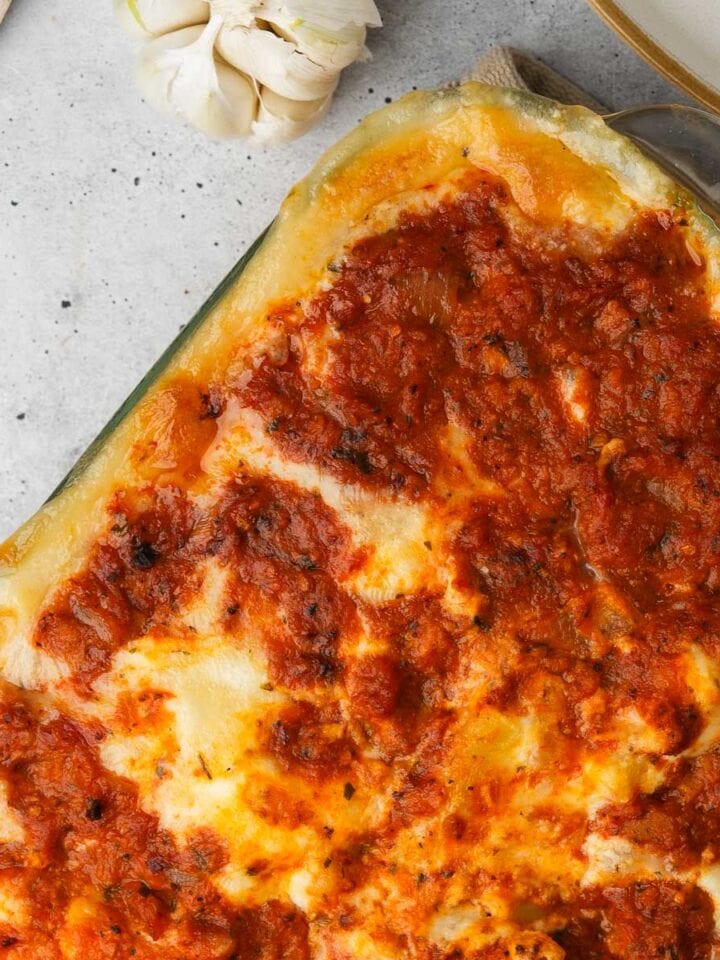


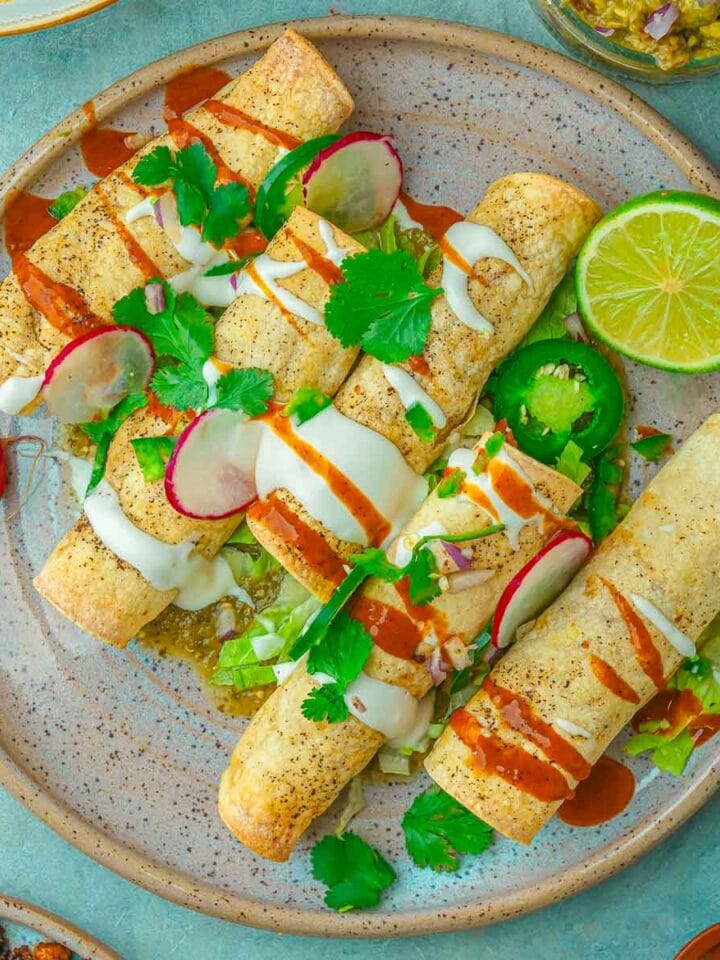

Shauna
Really delicious and surprisingly easy! The recipe list may make it seem complicated, but once you have everything it's very quick! And all the suggestions were helpful!
Jessica
We enjoyed this thoroughly - never would have thought I'd enjoy the slight zing of anise in a savory dish, but here we are! The substitutions and notes in the recipe were helpful. We didn't have scallions but the recipe didn't suffer for it. We also made our homemade kecap manis as outlined, and used a slightly thicker rice noodle (partner doesn't like the thin kinds). Looking forward to making this again!
Carol
Just a note that this is also great cold. I mixed in the leftover Napa and Scallions and a dash or 2 of mushroom soy sauce. Great flavor and crunch
Carol
It's a keeper! "Really good" from my husband. Made it as written with ramen noodles and some lightly fried shitakes. Def worth the hour drive to my favorite Asian Market in Boston. Good substitution notes too for some of the harder to find ingredients. Great flavor AND easy. Look forward to making it GF for family with Celiac. Excited to try more of your recipes
Adam Sobel
So glad you and your husband loved it Carol! The gluten-free version is not going to disappoint when you make it for your fam. I love this made with rice noodles. A big hot bowl o' noodles is my go to comfort food.